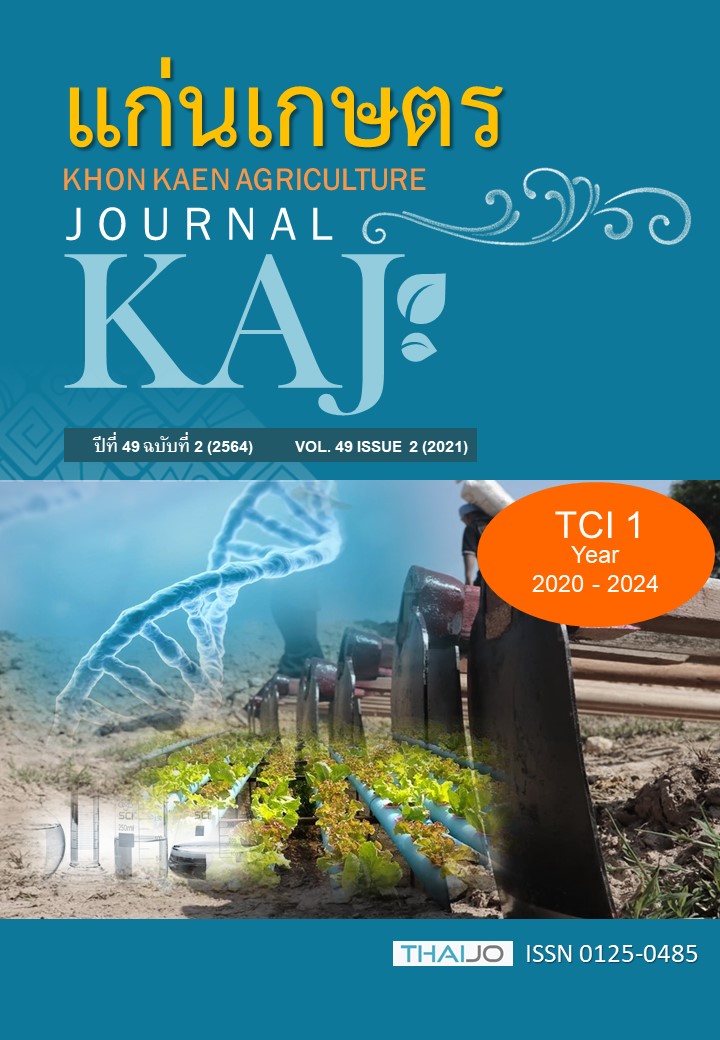ความสัมพันธ์ของปริมาณฟีนอลิก ฟลาโวนอยด์ และการต้านอนุมูลอิสระระหว่างการแปรผันชีพลักษณ์ในใบพลับ 2 ชนิด
Main Article Content
บทคัดย่อ
การศึกษาการเปลี่ยนแปลงปริมาณฟีนอลิก ฟลาโวนอยด์ และการต้านอนุมูลอิสระในใบพลับระหว่างการเจริญเติบโตของ Diospyros kaki จำนวน 2 พันธุ์ และกล้วยฤาษี (Diospyros glandulosa) โดยเก็บใบเพสลาดจากช่วงเวลาที่กำหนดตามชีพลักษณ์การเจริญเติบโตในระบบ BBCH-scale จำนวน 6 ระยะ (35, 71, 75, 85, 87, 93) ระหว่างเดือนมีนาคมถึงพฤศจิกายน พ.ศ. 2562 มาศึกษาลักษณะทางสัณฐานวิทยาและวิเคราะห์การเปลี่ยนแปลงปริมาณฟีนอลิก ฟลาโวนอยด์ และการต้านอนุมูลอิสระของใบในแต่ละระยะการเจริญเติบโตและศึกษาความแตกต่างระหว่างพลับพันธุ์ซิชู พันธุ์ฟูยู และกล้วยฤาษีสำหรับการนำไปใช้ประโยชน์จากใบ ผลการศึกษาพบว่า ใบของพลับพันธุ์ซิชูและพันธุ์ฟูยูมีขนาดใหญ่กว่าใบของกล้วยฤาษีที่มีรูปร่างเรียวยาว จากผลการวิเคราะห์ใบกล้วยฤาษีมีประสิทธิภาพต้านอนุมูลอิสระได้ดีกว่าของพันธุ์ซิชูและพันธุ์ฟูยูตั้งแต่ระยะ 71 - 93 ซึ่งอยู่ในช่วงเริ่มติดผลถึงก่อนสภาพพักตัวของต้น โดยการเติบโตของใบในรอบปีมีการเปลี่ยนแปลงปริมาณฟีนอลิก ฟลาโวนอยด์ และการต้านอนุมูลอิสระที่สัมพันธ์กัน ซึ่งมีค่าสหสัมพันธ์ระหว่างปริมาณฟีนอลิกและฟลาโวนอยด์แบบเชิงบวก ขณะที่แสดงผลแบบเชิงลบระหว่างค่า IC50 กับปริมาณฟีนอลิกเช่นเดียวกับค่า IC50 กับฟลาโวนอยด์ ดังนั้น การเพิ่มขึ้นของปริมาณฟีนอลิกและฟลาโวนอยด์ในใบส่งผลประสิทธิภาพต้านอนุมูลอิสระได้ดี จึงควรพิจารณาเลือกเก็บใบตามชนิดพันธุ์และช่วงเวลาการเจริญเติบโตเพื่อนำมาใช้ประโยชน์เป็นผลิตภัณฑ์ด้านสุขภาพ
Article Details

อนุญาตภายใต้เงื่อนไข Creative Commons Attribution-NonCommercial-NoDerivatives 4.0 International License.
เอกสารอ้างอิง
วสันต์ ชุณห์วิจิตรา. 2558. การปลูกพลับ. ข่าวสารเกษตรศาสตร์ มหาวิทยาลัยเกษตรศาสตร์. 60: 39-46.
สุรินทร์ นิลสำราญจิต. 2543. ไม้ผลเขตหนาว. ภาควิชาพืชสวน คณะเกษตรศาสตร์ มหาวิทยาลัยเชียงใหม่, เชียงใหม่.
สุรินทร์ นิลสำราญจิต และ สุริยา ตาเที่ยง. 2558. สัณฐานวิทยาเมล็ดและสารประกอบโพลีฟีนอลของลำไย. วารสารเกษตร. 31: 167-175.
องค์ความรู้เพื่อการพัฒนาพื้นที่สูง. 2559. บ่ากล้วยฤาษี (พลับป่า). แหล่งข้อมูล: https://hkm.hrdi.or.th/knowledge /detail/197. ค้นเมื่อ 15 พฤษภาคม 2563.
Al-Obaid, R.S.S. and D.H. Sahib. 2015. Determination of antioxidants activity in tea extract. American Journal of Biochemistry. 5: 49-52.
Augusto, T.R., E.S.S. Salinas, S. M. Alencar, M.A.B.R. Arce, A.C. Camargo, and T.M.F.S. Vieira. 2014. Phenolic compounds and antioxidant activity of hydroalcoholic extracts of wild and cultivated murtilla (Ugni molinae Turcz.). Journal of Food Science and Technology. 34: 667-673.
Chang, Y., J. Lin, H. Lin, P. Liao, P. Wu, and D. Yang. 2019. Phenolic compositions and antioxidant properties of leaves of eight persimmon varieties harvested in different periods. Food Chemistry. 298: 74-83.
Dahlia, F., S. Barouagui, H. Hemida, D. Bousaadia, and B. Rahmoune. 2020. Influence of environment variations on anti-glycaemic, anti-cholesterolemic, antioxidant and antimicrobial activities of natural wild fruits of Ziziphus lotus (L.). South African Journal of Botany. 132: 215 – 225.
Deetae, P., P. Parichanon, P. Trakunleewatthana, C. Chanseetis, and S. Lertsiri. 2012. Antioxidant and anti-glycation properties of Thai herbal teas in comparison with conventional teas. Food Chemistry. 133: 953-959.
Fitriansyah, S.N., I. Fidrianny, and K. Ruslan. 2017. Correlation of total phenolic, flavonoid and carotenoid content of Sesbania sesban (l. merr) leaves extract with DPPH scavenging activities. International Journal of Pharmacognosy and Phytochemical Research. 9: 89-94.
Garcia-carbonell, S., B. Yague, H. Bleiholder, H. Hack, U. Meier, and M. Agusti. 2002. Phenological growth stages of the persimmon tree (Diospyroe kaki). Annals of Applied Biology. 141: 73-76.
Hossain, H., K. Moon, and J. Kim. 2017. Antioxidant properties of Korean major persimmon (Diospyros kaki) leaves. Food Science and Biotechnology. 27: 177-184.
Pérez-Burillo, S., M.J. Oliveras, J. Quesada, J.A. Rufián-Henares, and S. Pastoriza. 2018. Relationship between composition and bioactivity of persimmon and kiwifruit. International Food Research Journal. 105: 461-472.
Pourmorad, F., S.J. Hosseinimehr, and N. Shahabimajd. 2006. Antioxidant activity, phenol and flavonoid contents of some selected Iranian medicinal plants. African Journal of Biotechnology. 5: 1142-1145.
Ramirez, M., M.V. Saenz, A. Vargas, and M. Araya. 2008. Leaf pruning intensities at flowering of banana (Musa AAA, cv. Grande Naine) did not influence fruit green and yellow life and quality. Scientia Horticulturae. 115: 319–322.
Sakanaka, S., Y. Tachibana, and Y. Okada. 2005. Preparation and antioxidant properties of extracts of Japanese persimmon leaf tea (kakinoha-cha). Food Chemistry. 89: 569-575.
Toplu, C., M. Kaplankiran, T.H. Demirkeser, E. Demir, E.E. Çandir, and E. Yildiz. 2009. The performance of persimmon (Diospyros kaki Thunb.) cultivas under mediterranean coastal conditions in Hatay, Turkey. Journal of the American Pomological Society. 63: 33-41.
Xie, C., Z. Xie, X. Xu, and D. Yang. 2015. Persimmon (Diospyros kaki L.) leaves: A review on traditional uses, phytochemistry and pharmacological properties. Journal of Ethnopharmacology. 163: 229-240.
Zou, Y., S. Liao, W. Shen, F. Liu, C. Tang, C.Y. Chen, and Y. Sun. 2012. Phenolics and antioxidant activity of mulberry leaves depend on cultivar and harvest month in Southern China. International Journal of Molecular Sciences. 13: 16544-16553.


